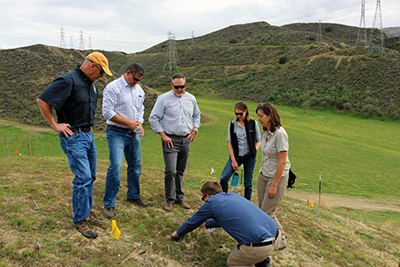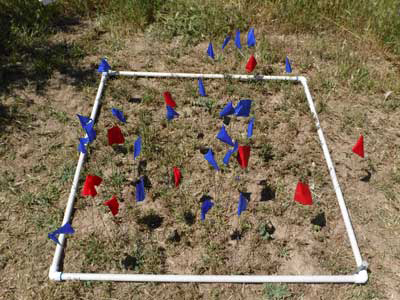
The San Fernando Valley spineflower, a tiny plant once believed extinct, has a promising future thanks to support from an unlikely source — a Southern California developer. That developer, FivePoint Holdings, LLC, is working with the U.S. Fish and Wildlife Service (Service) as well as other agencies to ensure that a plant found only two places in the world will continue to grow in its native habitat.
And, as the tiny, flowering buckwheat grows, so, too, will a master-planned community comprising 21,500 homes and employing 75,000 people. The project, Newhall Ranch, is taking shape west of Interstate 5 in the Santa Clarita Valley, about an hour drive northwest of Los Angeles.
The project, named for the ranch that once operated in northern Los Angeles County, is immense proof that commerce and conservation can be partners. The collaboration helped conservationists and developers realize their interests could complement each other.
It also highlights the increasing importance of public-private partnerships – particularly in land-constrained and ecologically sensitive regions like California – to accomplish vital environmental objectives.
“This is a success story,” said Emile Haddad, Chairman and CEO of FivePoint Holdings, LLC (FivePoint) the largest developer of master-planned communities in coastal California. “If you have an open mind, you can problem solve. A healthy economy can go hand in hand with a healthy environment.”
Newhall Ranch will preserve more than 10,000 acres of open space and establish more than 50 miles of walking trails. It will be the largest community in the United States that commits to a net zero increase in greenhouse gas emissions.
Those innovations helped end a decades-long battle from environmental groups to block development on the ranch. In 2017, an array of organizations opposed to the builder’s plans dropped their lawsuit. The project, they said, could go on.
As a result of collaborative, proactive conservation efforts, the Service announced in March that the San Fernando Valley spineflower was no longer at risk of becoming endangered in the foreseeable future. It withdrew a 2016 proposal to list the plant under the federal Endangered Species Act.
“This is a victory for proactive, partnership-driven conservation,” said Paul Souza, director of the Service’s Pacific Southwest Region. “Listing a species under the Endangered Species Act is neither a goal nor a measure of success. Working together with state, local and private partners to avert the need to list, saves taxpayer money, reduces the regulatory burden and ensures our wildlife thrive for future generations.”
The spineflower’s future looks bright, added Cat Darst, assistant field supervisor for the Service’s local field station in Ventura, California.
“We thought this plant was lost forever,” said Darst. “Now, less than 20 years later, it’s being reestablished in historical locations. To me, that means success.”
Part of that success: establishing a candidate conservation agreement, which secured the permanent conservation of over 1,500 acres in Los Angeles and Ventura counties for the spineflower’s benefit. Candidate conservation agreements are formal agreements between the Service and one or more parties to address the conservation needs of proposed or candidate species, or species likely to become candidates, before they become listed as endangered or threatened.
Presumed extinct for more than 70 years, the San Fernando Valley spineflower was rediscovered in 1999 in just two locations in Southern California: Ahmanson Ranch in Ventura County, which at the time was proposed for development; and Newhall ranch.
The discovery occurred the same year that the Service designated the spineflower as a candidate for listing under the Endangered Species Act. In 2001, California listed it as endangered under state law. The state’s 2003 acquisition of Ahmanson Ranch ensured that spineflower habitat would be protected in perpetuity at one geographic location, the Upper Las Virgenes Canyon.
Still, the Service was concerned for the plant’s future. Invasive grasses at the Upper Los Virgenes Canyon pose a threat to the population of the tiny annual buckwheat there. And as Newhall Ranch moved slowly through the approval process, botanists were concerned how its development might impact the spineflower. Finally, the presence of Argentine ants, common invaders in urban environments, could undermine the spineflower’s reproduction by displacing native ants, which are known spineflower pollinators.
“We needed to find a way to ensure spineflower populations could be sustainable in the long run,” Darst said.

With FivePoint’s commitment to environmental stewardship, botanists and restoration ecologists got busy developing a comprehensive conservation plan for the spineflower.
Nathan Gale and Anuja Parikh, a husband-and-wife botanist team fondly called the “spineflower whisperers,” were charged with finding spineflower plants in the field.
“Our claim to fame is that we’ve seen more spineflowers than anyone else on the planet,” said Gale. In 2000, the two rediscovered the San Fernando Valley spineflower at Newhall Ranch. Their work at the ranch, based on data collected from nearly a decade of survey and conservation planning, contributed to the development of a 2010 Spineflower Conservation Plan to protect, enhance and manage the Newhall spineflower population. This early plan created a 230-acre preserve system within the ranch that holds 75 percent of the Los Angeles County spineflower population, a critical stepping stone to further conservation efforts.
But Jodi McGraw, a botanist with 25 years of spineflower experience, knew preserving existing populations wouldn’t be enough.
“Once we understood the habitat that the spineflower needed, the question became: Can we establish this plant in suitable but unoccupied areas through the addition of seeds?” said McGraw, who joined the team working to preserve the Newhall spineflowers.
So the team started to think about potential reintroductions beyond the footprint of the Newhall Ranch development site, including where it existed historically and where it could grow in the future. Andy Thomson, a restoration ecologist with the environmental consulting firm Dudek, added his expertise. He helped lay the foundation for a spineflower introduction plan, including seeding trials. The goal: establish new spineflower populations in unoccupied areas, including sites that were historically occupied by the plant and entirely new locations with qualities of suitable spineflower habitat.
The team collected seeds from flowers and salvaged top soil that included the seedbank of the San Fernando Valley spineflower and stored them for safekeeping at the Rancho Santa Ana Botanic Gardens and National Seed Lab in Colorado. Seeding trials began in 2016 at two sites adjacent to existing spineflower preserves established by the 2010 Spineflower Conservation Plan.
It was a success.
“From a return-on-investment perspective, we had 30 times as many seeds produced as were put out into the ground,” McGraw said. “One of our highest performing plants produced up to 10,000 flowers.”
Buoyed by that early success, the Service and FivePoint formalized plans for introduction of the spineflower in a candidate conservation agreement in 2017. That plan secured the permanent conservation of over 1,500 acres in Los Angeles and Ventura counties for the benefit of the spineflower.
“FivePoint has committed the resources needed for this to be a successful introduction with long-term management and monitoring,” Thomson said.
FivePoint has dedicated more than $8 million to fund the establishment of the spineflower and long-term conservation and management of the new sites. That number is in addition to approximately $10 million in habitat enhancements and endowments for long-term management efforts on the ranch that FivePoint is already funding through the 2010 spineflower conservation plan.
“Newhall Ranch will create a new paradigm for response community building and a model for living and working sustainably in California,” Haddad said. “By harnessing innovation and collaborating with leading public agencies and environmental organizations, we will create a new standard of environmental sustainability and a lasting investment in our future.”
The Service will evaluate both implementation and effectiveness of conservation measures over the next 10 years, said Darst.
“The level of commitment to this plant,” she said, “is unprecedented.”
 Sign In
Sign In
 Sign In
Sign In
